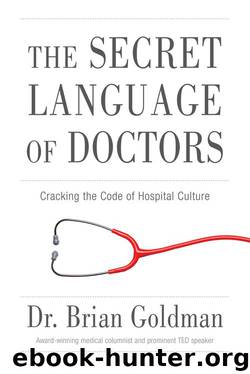The Secret Language of Doctors by Brian Goldman

Author:Brian Goldman [Goldman, Brian]
Language: eng
Format: epub
ISBN: 9781633191792
Publisher: Triumph Books
Published: 2015-04-01T04:00:00+00:00
9. Harpooning the Whale
On November 24, 2011, the British newspaper the Daily Mail reported that Arthur Berkowitz, a 57-year-old passenger on US Airways Flight 901, had to stand for most of the seven hours it took to fly from Anchorage, Alaska, to Philadelphia. The reason? His 400-pound seatmate was so large that when both armrests were raised to accommodate him, the man’s bulk spilled over onto Berkowitz’s seat.
“He was a real gentleman,” Berkowitz told reporters. “The first thing he said to me was: ‘I want to apologize—I’m your worst nightmare.’”
Patients as large as the man seated next to Berkowitz are many a doctor’s worst nightmare too. Obese and overweight patients represent a plentiful source of new and ongoing business for doctors—and a rather rich source of recent medical slang that is often vicious and pointed. Anesthesiologists have a telling bit of medical argot they use to describe the exercise of inserting an epidural catheter—a flexible tube that’s placed through the back into a space in the spinal canal to deliver pain-relief medication—into an obese woman in the late stages of labour. They call it “harpooning the whale.”
“I’ve heard it many times,” says Dr. Jay Ross, an anesthesiologist, who is quick to point out he doesn’t utter the phrase himself.
The harpoon is the extra-long Tuohy needle used to insert an epidural catheter. A hollow hypodermic needle with a slight curve at the end, the Tuohy was developed to get through the extra layers of tissue in the back. It has to be threaded precisely between the vertebrae in the back. The whale part is self-explanatory.
“You have to get through the skin, the fat and all that,” says Ross. “A lot of obese patients have so much fat on their back that you’re often struggling to even feel the spinous processes to insert the epidural or the spinal needle in the first place. Sometimes I’ll actually ask the patient if it feels like I have placed the needle on the left or the right of the midline.”
Increasingly, anesthesiologists use a portable ultrasound machine to locate the epidural space that is the destination of the needle. However, for the many anesthesiologists who don’t have one, it’s a matter of guesswork. Ross says that with a pregnant woman of average weight, it takes about fifteen minutes to insert an epidural. For obese women, it can take as long as forty-five minutes—even longer. The longer it takes to put in an epidural, the less likely the pain meds will kick in time for the critical stage of labour in which the woman is encouraged to push. Increasingly, Ross and his colleagues warn obese patients up front that there’s trouble ahead.
“I used to be very reticent about doing that,” says Ross. “I’m a lot less so now because I think there’s no real point in beating around the bush. If you don’t do it, then they’re sort of wondering why you’re stabbing their back multiple times for forty-five minutes. It can be very frustrating.”
That frustration has turned anesthesiologists into slangmeisters.
Download
This site does not store any files on its server. We only index and link to content provided by other sites. Please contact the content providers to delete copyright contents if any and email us, we'll remove relevant links or contents immediately.
When Breath Becomes Air by Paul Kalanithi(7296)
Why We Sleep: Unlocking the Power of Sleep and Dreams by Matthew Walker(5680)
Paper Towns by Green John(4193)
The Immortal Life of Henrietta Lacks by Rebecca Skloot(3843)
The Sports Rules Book by Human Kinetics(3616)
Dynamic Alignment Through Imagery by Eric Franklin(3512)
ACSM's Complete Guide to Fitness & Health by ACSM(3483)
Kaplan MCAT Organic Chemistry Review: Created for MCAT 2015 (Kaplan Test Prep) by Kaplan(3439)
Introduction to Kinesiology by Shirl J. Hoffman(3317)
Livewired by David Eagleman(3158)
The River of Consciousness by Oliver Sacks(3009)
Alchemy and Alchemists by C. J. S. Thompson(2924)
The Death of the Heart by Elizabeth Bowen(2921)
Descartes' Error by Antonio Damasio(2757)
Bad Pharma by Ben Goldacre(2745)
The Gene: An Intimate History by Siddhartha Mukherjee(2510)
Kaplan MCAT Behavioral Sciences Review: Created for MCAT 2015 (Kaplan Test Prep) by Kaplan(2501)
The Fate of Rome: Climate, Disease, and the End of an Empire (The Princeton History of the Ancient World) by Kyle Harper(2452)
The Emperor of All Maladies: A Biography of Cancer by Siddhartha Mukherjee(2446)
